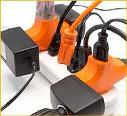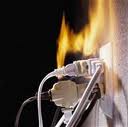
Electrical Dangers at Home
Extension Cords
Extension cords can be more dangerous than you think. I have read that according the CPSC (consumer protection safety commission) estimates that extension cords cause about 3,300 residential fires each year, killing 50 people and injuring about 270 others. Additional injuries occur by tripping over extension cords, even more concerning for elderly and disabled persons.
I find that builders of homes to keep costs down under install outlets opening the need to use extension cords. They meet min. requirements according to applicable codes, but in my view is that the coverage in some areas often lack enough outlets. There should never be a need to have to cross a doorway with an extension cord because no wall outlet exists, but I have seen many homes that leave parts without electrical outlet coverage. Builders have no obligation to exceed code requirements and a good lot of times will not. If the outlets where better placed and more outlets where provided, the need for extension cord use would greatly decrease.
Entertainment centers can require a lot of items to be plugged in with perhaps only one nearby outlet.
Where the only way is to use an extension cord…
a) do not run under rugs / carpet. Heat cannot escape, walking over the area can lead to damaged cords which then becomes a fire hazard.
b) make certain the extension cord is rated to handle more current then what is required for the item’s plugged into the extension cord

Portable heaters draw a significant current load, and even though the wall outlet can handle it, using undersized / under rated extension cords can start a fire.
c) Never attempt to plug a 3 prong (equipment grounded) item into an extension cord that only accepts a 2 prong plug. Never cut the ground prong off in order to make it fit an extension cord that only accepts a 2 prong plug.
d) Do not use a 100 foot extension when only a very short one is required.
Also do not tightly wind up into a coil an excessive length extension, to give the reasons why I have to give a brief description on how a transformer works, a transformer works by having two independent wire winding over each other often with an iron core center. Electrical current generates an electro magnetic field, AC (alternating current) is constantly changing and that rise and fall induces a electrical current in the secondary winding. The ratio of the primary and secondary winds as well as the core will determine if it is a step up or step down voltage transformer.
A lengthy tightly coiled extension cable although not that efficient as a properly manufactured transformer and even though it is essentially one winding, it can still have an affect on the coiled cable. I have experienced this first hand as I work in a television broadcast station, and many years ago I recall an instance where we had a 100 to 200 foot lighting cable coiled up with a high current studio lights attached to the end of it. The electrical cable was of the highest quality and high amp rating, but even so because a very lengthy amount of cable was in coil, with the effect of magnetic flux the cable literally started smoking.
e) Do not use multiple extensions together…

This is a fire waiting to happen

Not as bad as the above example, but also do not use multiple extensions into other extensions

Another example of a dangerous multiple use of extensions
f) If you have a major entertainment center with numerous power connections to make, use a high quality surge protected grounded power bar, do not use additional extension cords plugged into the power bar. The safety of all the electrical connections is only as good as the weakest link.
g) any arcing in the connections or damaged cords, do not risk it, replace them.
h) Always disconnect / remove extension cords that are not in use, small children could put these in their mouth, moisture from the mouth can get into the plug connections and the resultant electrical shock could be fatal.
In some circumstances it may be better and safer to have a new outlet and / or new circuit installed.
UL (underwriters laboratory) tests a variety of products including extensions cords and those approved carry the UL tag on them, you still have to pay attention to the warning and ratings on these cables to ensure they are suitable for the use intended. There has also been some inferior counterfeit extensions cables that have come on the market that appear to have the UL tag but are not.
WHILE EXTREME CARE HAS BEEN IMPLEMENTED IN THE PREPARATION OF THIS SELF-HELP DOCUMENT, THE AUTHOR AND/OR PROVIDERS OF THIS DOCUMENT ASSUMES NO RESPONSIBILITY FOR ERRORS OR OMISSIONS, NOR IS ANY LIABILITY ASSUMED FROM THE USE OF THE INFORMATION, CONTAINED IN THIS DOCUMENT, BY THE AUTHOR and / OR PROVIDER.
By: Donald Kerr